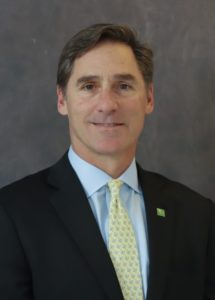5 Questions with TD Wealth’s new head of US distribution
In this monthly Q&A segment, Bank Innovation features executives and industry thought leaders who highlight technology and innovation trends in financial services, and explores strategy and best practices in leading financial institutions.

As Alan Chabot steps into to his new role as TD Wealth’s head of U.S. distribution, the banking veteran is eyeing investments in tools and technology that will accelerate the firm’s growth.
Chabot’s career has included stints at some of the largest financial institutions in the U.S., as CEO at both Santander Securities and Chase Investment Services, and COO for Citi Private Bank EMEA. Through the years, he has built a reputation for aggressively growing businesses through collaboration. While at Chase, for instance, Chabot more than doubled the number of advisors to 3,000 from 1,400 in a matter of a few years. At the helm of TD’s U.S. wealth distribution strategy, he will focus on the partnerships forged in the financial advice business and look to technology that strengthens those connections.
In this edition of 5 Questions With, Bank Innovation speaks with Chabot about how the firm will build upon its financial planning technology, headwinds facing the wealth management industry and the lasting impacts the coronavirus pandemic might have on the financial advice industry. What follows is an edited version of his conversation with BI.
Bank Innovation: Your career has taken you to the most senior leadership positions at some of the largest financial institutions in the country. How are your past experiences going to help guide you in your new role?
Alan Chabot: My career’s formative years were at Smith Barney, which was a traditional brokerage firm that grew into a wealth management firm over time. While I was there, Jamie Dimon was CEO and his leadership style ran through the organization. It really started with talking about clients first. If you put clients first and you find great people to work in the company, you usually come up with quick results.
In 2008, I moved over to JPMorgan Chase where I was more focused on the affluent segment inside of the bank’s retail operation. And What I saw firsthand was the power of an incredibly successful partnership between qualified investment professionals and a retail bank, and the power of trust that’s created with your retail bank on the corner combined with offering investment solutions for appropriate clients in that context. I learned a lot about how to marry investment solutions with retail banking in an appropriate way for appropriate clients.
BI: What is a tool or technology you’d like to implement into TD Wealth’s strategy by 2021?
AC: A lot of the technology and capabilities we need to serve our clients already exist, and one capability we will continue to build upon is overall financial planning for all our clients. So that’s making sure every client has a robust financial plan that will help them achieve their goals.
The history of our industry is a little bit individual-solution oriented and one of the things we’re trying to bring to the overall picture is making sure that everyone has a robust plan and really has thought through their long-term needs and goals, and that they can continue to check in with their advisor —and by themselves if they want to — to make sure they’re on track.
We use technology, an industry-leading financial planning software called PIEtech, to enable our advisors to build those plans and update and maintain our plans but it’s really that ongoing discussion, dialogue and interaction between the client and advisor that makes the tool effective. The tool helps us ask all the right questions and to do so in different ways with different embedded strategies, like the Monte Carlo analysis, which is a way of projecting what’s going to happen in the markets and the likelihood of certain outcomes.
In terms of how we can expand the use, we just continue to train our folks on the capabilities of the tools. We’re just launching our mass affluent capabilities in the retail stores at TD and the use of the planning tool will be a core element of our launch.
BI: What do you see as the biggest challenge in wealth management, sales and distribution?
AC: We have fee compression across our industry and so we are going to continue to be challenged with having larger client bases and needing to provide service to more clients with larger client bases but, at the same time, still providing that individualized and customized advice service that we all want to provide. That fee compression is another challenge we all face in the industry and we’re certainly facing it here. Another challenge we have in our industry is we want to hire the best of the best, people with intellect, energy and ethics every single time. As we think about scaling our operation, technology is absolutely part of the solution. The better we buy tools and develop our own tools to enable our people to be efficient in their communication with clients, the better we can meet that challenge.
We’ll continue to be a buyer and developer of those kinds of technology, whether its CRM or financial planning software like I mentioned. We leverage both of those.
BI: And what do you see as the biggest opportunity in your field as you step into your new role?
AC: The opportunity at TD is absolutely tremendous and I’m looking forward to seizing that opportunity to the greatest extent possible, but on a relative basis, we still have a lot of room for growth in wealth at TD. If you look at the overall wealth services exposure at the stores and commercial bank, TD’s approach has been a relatively light touch.
We want to increase that and make sure we have more people working with the retail bankers, as well as with the commercial bankers, to offer our wealth services to clients that are appropriate and penetrate our existing customer base as well as future prospects and hopefully we can earn a fair number of referrals and really grow our business significantly.
BI: How do you see wealth management evolving after the coronavirus crisis and what have you already learned from it?
AC: I think some of these remote capabilities are going to become permanent fixtures in how we engage with clients. Some folks are not going to re-engage in a face-to-face setting immediately, so we’ll continue to work with those folks remotely.
When you think about our business, a lot of the initial relationships start face to face, but a lot of our delivery, historically, has been telephonic and with that in mind, our approach doesn’t have to change. Some of that communication will go to video and that’s a good thing. It’s good for clients, it’s good for us, and therefore it’s a good efficiency enhancement.












